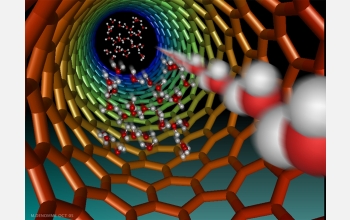|

Press Release 05-194
Slippery When Wet

Fluids race through nearly frictionless carbon nanotubes
November 10, 2005
Within the cells of our bodies, fluids flow rapidly through miniscule, nearly frictionless, protein channels. Until now, human-made nanoscale structures have not been able to mimic those same speeds because the fluids flow slowly along the walls of the tiny structures.
Researchers have now found that carbon nanotubes only 7 billionths of a meter in diameter can channel many fluids nearly friction free. With some fluids, the interiors of the tubes were so slippery that substances sailed through 10,000-100,000 times faster than models had predicted.
For the experiments, chemical and materials engineers Bruce Hinds, a National Science Foundation CAREER awardee, Mainak Majumder, Nitin Chopra and Rodney Andrews of the University of Kentucky fabricated membranes made from billions of aligned carbon nanotubes. The fabrication techniques easily adapt to large-scale production, which is important for industries that could use such membranes for separating commodity chemicals.
Hinds and his colleagues crafted the membranes so that each side can have different chemical properties. As a result, the selective membrane could one day be used to deliver drugs through the skin or in specialized chemical sensors.
The findings appeared in the Oct. 3, 2005, issue of the journal Nature.
-NSF-

Media Contacts
Joshua A. Chamot, NSF (703) 292-7730 jchamot@nsf.gov
Dan Adkins, University of Kentucky (859) 257-1754 dradki1@email.uky.edu
Program Contacts
Geoffrey A. Prentice, NSF (703) 292-8371 gprentic@nsf.gov
Principal Investigators
Bruce Hinds, University of Kentucky (859) 257-2300 bjhinds@engr.uky.edu
Related Websites
Bruce Hinds laboratory: www.engr.uky.edu/~bjhinds
University of Kentucky press release: http://news.uky.edu/news/display_article.php?category=1&artid=736

The National Science Foundation (NSF) is an independent federal agency that
supports fundamental research and education across all fields of science and
engineering, with an annual budget of $6.06 billion. NSF funds reach all 50
states through grants to over 1,900 universities and institutions. Each year,
NSF receives about 45,000 competitive requests for funding, and makes over
11,500 new funding awards. NSF also awards over $400 million in
professional and service contracts yearly.
 Get News Updates by Email Get News Updates by Email
Useful NSF Web Sites:
NSF Home Page: http://www.nsf.gov
NSF News: http://www.nsf.gov/news/
For the News Media: http://www.nsf.gov/news/newsroom.jsp
Science and Engineering Statistics: http://www.nsf.gov/statistics/
Awards Searches: http://www.nsf.gov/awardsearch/
| 


